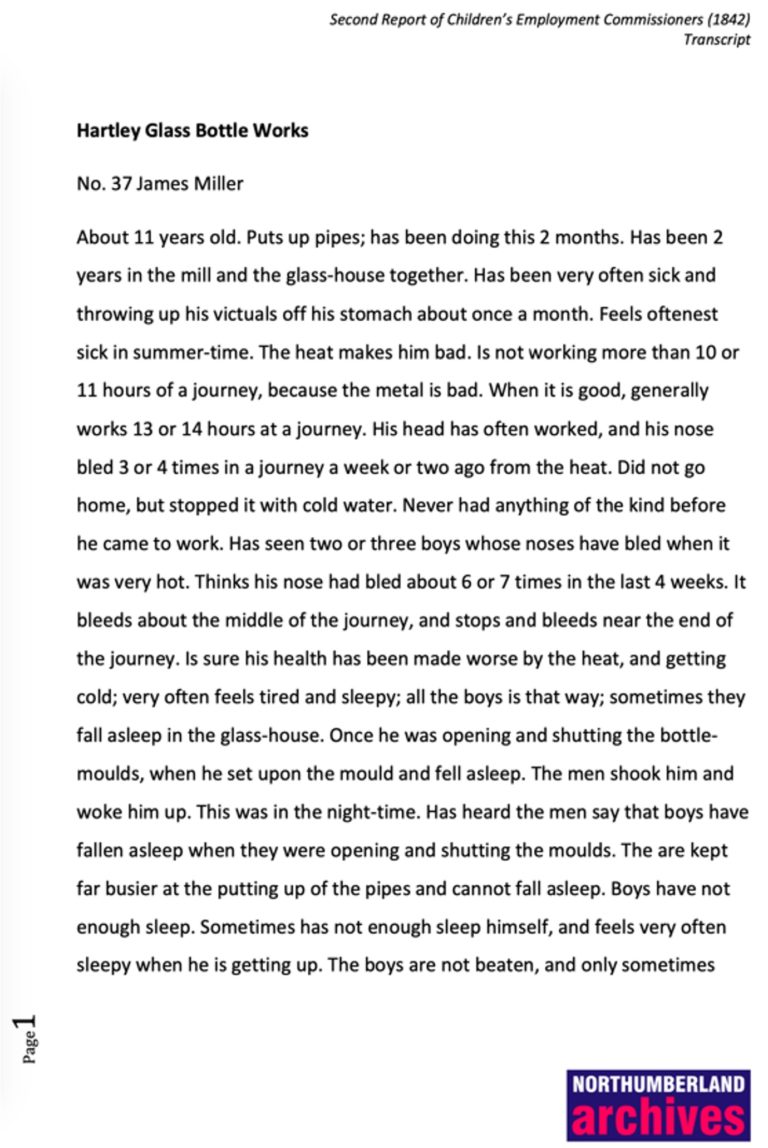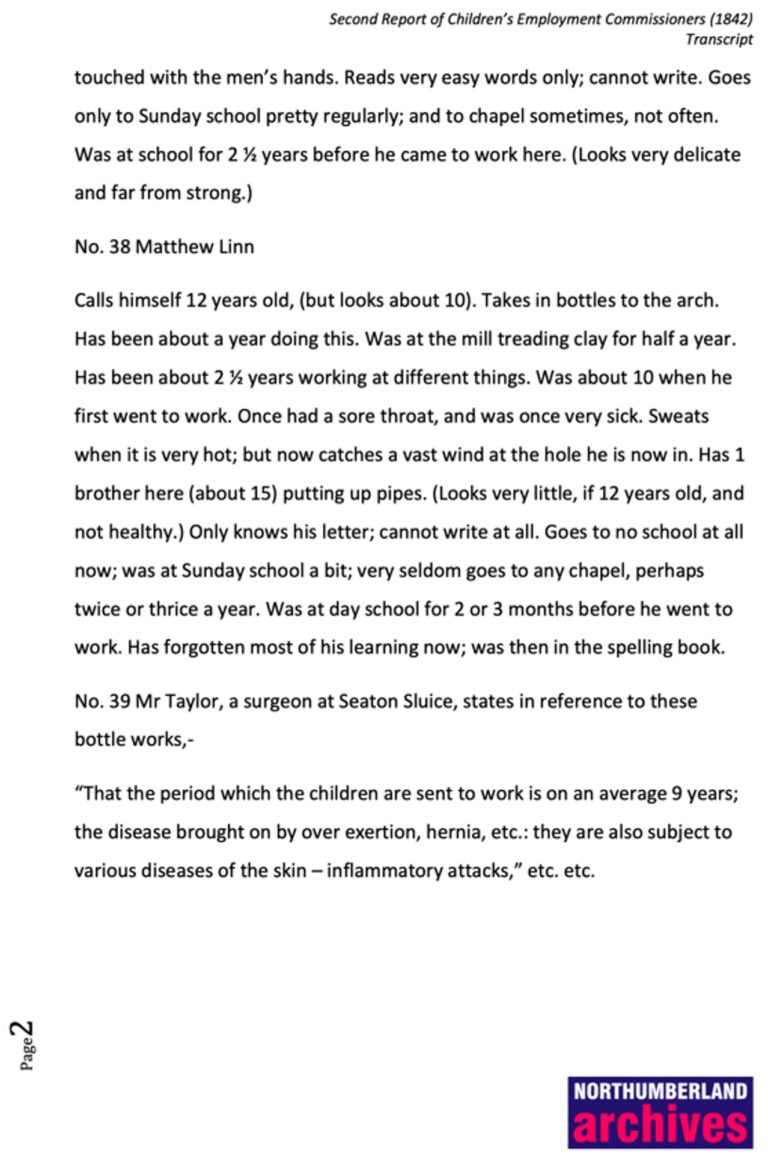Hartley Bottle Works: Transcript of second report of children’s employment commissioners, 1842
Reference: Second Report of Children’s Employment Commissioners (1842) Transcript
Suggested age groups: KS1, KS2, KS3, KS4, Lifelong Learners
Subject areas: History, Literacy, Art, Citizenship, Science, Geography
CONTEXT
In 1840 Parliament set up the Children’s Employment Commission. The aim of the Commission was to investigate the working conditions of children under the age of 18. The first report included the commission’s findings on the state of child employment in mines, the second in other industries, and the third in factories. The commission was set up by Lord Ashley, Earl of Shaftesbury. He also campaigned for improved conditions and education for children working in factories and for the banning of chimney sweeps.
The commission employed inspectors who were responsible for a region of the country. The inspectors gave out forms for owners to fill in about their employees (see Wylam Colliery form), but also talked to children and other adults involved in the industry. For example, the “surgeon” or doctor in Seaton Sluice was interviewed when the inspector went to Hartley Bottle Works.
Hartley Bottle Works was opened in 1763 by the Delaval family. The Delavals invested in the industries around Seaton Sluice, including the colliery, salt pans and the bottle works. Their industries all depended on the harbour at Seaton Sluice for shipping that could then transport the goods and materials. The harbour was created in 1764 by the Delaval family by cutting through solid rock.
The Bottle Works was sometimes referred to as “The City” because it was self-contained. It included a marketplace, brewery, and granary, while its workers lived in housing built by the Delavals. There was even a company doctor who was paid for from “deductions” from the workers’ wages – the money was taken out of their pay before they received it.
It has been said that no man could earn money at Seaton Sluice and spend it elsewhere. This might be because they had everything that they needed where they worked and lived, or it might have been that they couldn’t spend their “money” elsewhere. In the late eighteenth century, some industrialists took advantage of a shortage of coinage in the country. Rather than paying their workers in legal coinage, they used their own tokens. These tokens could only be used in local shops, which were often owned by the factory owners.
Arch – oven heated to a high temperature. Semi-finished bottles put here for “annealing” – they are allowed to cool slowly in a uniform way so that they don’t shatter
Hole – in the furnace. Pipes are placed in the holes to heat and remove molten glass
Journey – the contents of one furnace. Usually 10-15 hours work to process
Metal – molten glass
Pipe – long metal pipe used to get molten glass from furnace
Putter-up – boy who assists the men who work the glass into their finished shapes
ACTIVITIES
ACTIVITY 1
Background
In 1840 Parliament set up the Children’s Employment Commission. The aim of the Commission was to investigate the working conditions of children under the age of 18. The first report included the commission’s findings on the state of child employment in mines, the second in other industries, and the third in factories.
The commission was set up by Lord Ashley, Earl of Shaftesbury. He also campaigned for improved conditions and education for children working in factories and for the banning of chimney sweeps.
SEE
See: When did Parliament set up the Children’s Employment Commission?
See: What was the aim of the Children’s Employment Commission?
See: What did the Children’s Employment Commission investigate?
See: Who set up the Commission?
See: What did Lord Ashley, Earl of Shaftsbury campaign for?
THINK
Think: Why was the Children’s Employment Commission set up?
Think: Why did children under 18 work in industry?
Think: What types of jobs did the children do in industry?
Think: What types of conditions did the children work in?
Think: What types of backgrounds do you think the children who worked in industry came from?
Think: Do you think the children chose to go to work in industry or do you think some may not have been given a choice?
DO
Do: Create a comic strip using the words from the glossary to illustrate their definitions.
Do: Imagine what it might have been like for a child in the bottle works. Think about what they might have felt, what job they might have had to do, what they could see, smell, hear, taste and touch. Write a poem or a monologue from the perspective of a child worker at Hartley Bottle Works.
Do: Create an interpretive piece of music to play while you perform your poem or monologue. This could be inspired by the sounds that the children may have heard at work.
Do: Perform your poem or monologue with your accompanying piece of music.
Do: Research the illnesses mentioned in the transcript. Write a report about the health conditions suffered by the children working at the bottle works and present it as though you are Mr Taylor, the surgeon, presenting it to the interviewer. What long term effects may these health conditions have on the child workers?
Resources
ACTIVITY 2
Background
Hartley Bottle Works was opened in 1763 by the Delaval family. The Delavals invested in the industries around Seaton Sluice, including the colliery, salt pans and the bottle works. Their industries all depended on the harbour at Seaton Sluice for shipping that could then transport the goods and materials. The harbour was created in 1764 by the Delaval family by cutting through solid rock.
The Bottle Works was sometimes referred to as “The City” because it was self-contained. It included a marketplace, brewery, and granary, while its workers lived in housing built by the Delavals.
In the late eighteenth century, some industrialists took advantage of a shortage of coinage in the country. Rather than paying their workers in legal coinage, they used their own tokens. These tokens could only be used in local shops, which were often owned by the factory owners.
SEE
See: Who owned Hartley Bottle Works?
See: Where was Hartley Bottle Works?
See: Why did Hartley Bottle Works depend on the harbour?
See: Why was the Bottle Works referred to as “The City”?
See: How were the workers paid?
THINK
Think: Why might the Delavals and other industrialists have paid their staff using tokens that could only be used in local shops?
Think: Do you think it was a good idea for the Bottle Works to be a self-contained “city”?
Think: How is glass made? What materials might the glass industry need access to?
Think: Why was having access to a harbour so important to industry?
Think: What is sea glass, how is it made and where does it come from?
DO
Do: Using Google Maps, look at Seaton Sluice. Which natural, environmental and man-made features made it a good location for the Bottle Works?
Do: Imagine you are going to set up a new bottle works. Write a list of the natural, environmental and man-made features that you would look for when deciding a location.
Do: Using Google Maps, try to identify a nearby location for your bottle works using your list of ideal features.
Do: Design a self-contained city for your bottle works. What types of businesses would you include? What types of housing would you need?
Do: Create a business plan for your bottle works. Think about who you would employ, what types of jobs they would do, how you would pay them, how you would transport goods etc.
Do: Design your own token that your staff could be paid with.
Do: Is it ethical to pay staff using tokens that can only be used in businesses owned by the employer? In groups, debate the pros and cons of paying staff using tokens. Consider both the factory owners’ and the employee’s perspectives.
Do: Visit the beach and try to find some sea glass. If you don’t have access to the beach you could purchase some online. Using your sea glass, create an artwork by transferring old images of the Glass Works onto the sea glass using the technique shown by the Art in Red Wagons website.
Resources
http://www.bbc.co.uk/tyne/content/articles/2005/07/04/coast05walks_stage5_walk.shtml
https://artinredwagons.blogspot.com/2012/11/photo-transfer-on-glass.html
https://www.burradonhistory.co.uk/2013/07/seaton-sluice-bottleworks.html
http://www.keystothepast.info/article/10339/Site-Details?PRN=N12006
https://www.bclm.co.uk/items/1790-john-wilkinson-token/1404.htm
https://www.theguardian.com/society/gallery/2010/sep/21/trade-tokens-local-currencies
http://www.thecoppercorner.com/history/18thC_hist.html
https://www.scienceabc.com/nature/what-is-sea-glass-and-where-does-it-come-from.html
OTHER ONLINE RESOURCES
Lord Shaftesbury
Spartacus Educational website, page for Lord Ashley, Earl of Shaftesbury: https://spartacus-educational.com/IRashley.htm
Glass Making
Sunderland Glass Centre website, page with videos of glass making demonstrations: https://sunderlandculture.org.uk/our-venues/national-glass-centre/glass-making-demonstrations/
BBC Teach website, page with video on how glass is made: https://www.bbc.co.uk/teach/class-clips-video/primary-science-how-glass_is_made/zm2tf4j
Explain that Stuff (US) website, page about the making of glass: https://www.explainthatstuff.com/glass.html#:~:text=You%20can%20make%20glass%20by,C%20(3090%C2%B0F)
History of Hartley Bottle Works, Seaton Sluice
BBC Tyne website, page for walk in Seaton Sluice including history of Hartley Bottle Works: http://www.bbc.co.uk/tyne/content/articles/2005/07/04/coast05walks_stage5_walk.shtml
Seaton Sluice and Old Hartley Local History Society, page for history of Hartley Bottleworks: www.seaton-sluice.btck.co.uk/BottleWorks
Burradon and Northumberland Past website, page about Hartley Bottle Works: https://www.burradonhistory.co.uk/2013/07/seaton-sluice-bottleworks.html
Northumberland Archives Exhibitions website, page for Seaton Sluice (see down left side for photographs, documents and maps): https://communities.northumberland.gov.uk/Seaton%20Sluice.htm
Keys to the Past website (Northumberland Historic Environment Record) website, page for Seaton Sluice: http://www.keystothepast.info/article/10339/Site-Details?PRN=N12006
Grace’s Guide website, page with timeline for John Hussey Delaval: https://www.gracesguide.co.uk/John_Hussey_Delaval
Payment Tokens
Black Country Living Museum website, page about payment tokens: https://www.bclm.co.uk/items/1790-john-wilkinson-token/1404.htm
Guardian website, page for pictures of payment tokens: https://www.theguardian.com/society/gallery/2010/sep/21/trade-tokens-local-currencies
The Copper Corner (coin collecting) website, page about payment tokens: http://www.thecoppercorner.com/history/18thC_hist.html



